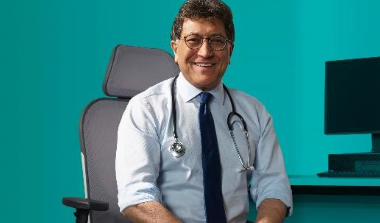Trigger finger occurs when your finger becomes ‘locked’ in position in the palm of your hand and is difficult to straighten. This happens when the tendon in the palm of your hand thickens and gets stuck.
What is trigger finger surgery?
Your doctor may recommend surgery to correct your trigger finger, usually if other treatments such as steroid injections, anti-inflammatories and a splint have proven unsuccessful.
In many cases, the cause of trigger finger is unknown. However it is a condition that is more likely to affect women than men and is more common in people in their 40s and 50s. You may also be more likely to develop trigger finger if you have previously injured your hand, or have certain pre-existing medical conditions including diabetes, rheumatoid arthritis, gout, carpal tunnel syndrome, Dupuytren’s contracture and some other hand conditions.
If you decide to have your treatment with us, you will be looked after by an experienced multi-disciplinary care team.
How much does Trigger finger release cost at Spire Liverpool Hospital
We can't display a fee for this procedure just now. Please contact us for a quote.
When is trigger finger surgery needed?
Our patients are at the heart of what we do and we want you to be in control of your care. To us, that means you can choose the consultant you want to see, and when you want. They'll be with you every step of the way.
All of our consultants are of the highest calibre and benefit from working in our modern, well-equipped hospitals.
Our consultants have high standards to meet, often holding specialist NHS posts and delivering expertise in complex sub-specialty surgeries. Many of our consultants have international reputations for their research in their specialised field.
Before trigger finger surgery
You will have a formal consultation with a healthcare professional. During this time you will be able to explain your medical history, symptoms and raise any concerns that you might have.
We will also discuss with you whether any further diagnostic tests, such as scans or blood tests, are needed. Any additional costs will be discussed before further tests are carried out.
Preparing for trigger finger surgery
We've tried to make your experience with us as easy and relaxed as possible.
For more information on visiting hours, our food, what to pack if you're staying with us, parking and all those other important practicalities, please visit our patient information pages.
Our dedicated team will also give you tailored advice to follow in the run up to your visit.
Trigger finger surgery procedure
We understand that having surgery can potentially be a time of anxiety and worry. Our experienced and caring medical staff will be there for you, providing reassurance every step of the way.
Your operation may be done under general anaesthesia, which means you'll be asleep during the procedure, or under local anaesthesia, which means you'll be awake but your hand will be numb. It usually takes about 15 to 20 minutes. If you're having the operation under local anaesthesia, we may offer you a sedative to help you relax. This may also make it easier for you to keep your hand still during the procedure.
Your surgeon will make a small cut in your palm to get to the tendon and release it. He or she will then close the cut using stitches.
Your surgeon may give you an injection of a long-acting local anaesthetic around the operation site to keep the area pain free afterwards.
Trigger finger surgery recovery time
Trigger finger release is usually performed as a day case so you won't need to stay overnight in hospital.
After the procedure, you will be taken from the operating theatre to a recovery room, where you will come round from the anaesthesia under close supervision.
After this, you will be taken to your room or comfortable area where you can rest and recuperate until we feel you’re ready to go home.
A physiotherapist will visit you and show you gentle exercises that will strengthen your hand and keep your joints mobile.
Pain relief
After surgery, you may have some pain, swelling and bruising around the operation site. This may last for a week or two, or until the wound heals.
If your surgeon injected you with a long-acting local anaesthetic around the operation site to keep the area pain free afterwards, your palm and fingers may feel numb for up to 10 hours. After this wears off, you can take over the counter pain relief to ease any discomfort.
Recovery time
You will usually have your stitches removed about seven to 14 days after the operation but if you have dissolvable stitches, they will disappear on their own in seven to 10 days. Afterwards, the scar will feel quite firm and tender.
Follow your surgeon’s advice about driving, returning to work, heavy lifting and sport. A full recovery can take up to a month.
In some cases, the symptoms of trigger finger return needing further surgery. This is more likely if you have diabetes.
How your loved ones can help
Once you’re ready to be discharged from hospital, you’ll need to arrange a taxi, friend or family member to take you home as you won’t be able to drive. You should not drive until you feel you could do an emergency stop without discomfort.
Looking after you
Even after you’ve left hospital, we’re still looking after you every step of the way. After trigger finger release surgery, we will provide you with all the appropriate medication, physiotherapy exercises, advice on what to do and not to do with your finger and follow-up support.
On rare occasions, complications following trigger finger release can occur. Please call us straight away if you experience any of these symptoms
- becomes more painful
- gets red, swollen or hot
- smells unpleasant or oozes liquid
The possible complications of any surgery include an unexpected reaction to the anaesthetic, excessive bleeding, infection or developing a blood clot, usually in a vein in one of your legs (deep vein thrombosis, DVT). Complications specific to a trigger finger release include a small risk of injury to other nerves, blood vessels or tendons in the hand.
The chance of complications depends on the exact type of operation you are having and other factors such as your general health. We will talk to you about the possible risks and complications of having this procedure and how they apply to you.
If you have any questions or concerns, we're here to help.
Why Spire Liverpool Hospital is the best choice
We are committed to delivering excellent individual care and customer service across our network of hospitals, clinics and specialist care centres around the UK. Our dedicated and highly trained team aim to achieve consistently excellent results. For us it's more than just treating patients, it's about looking after people.
Find Spire Liverpool Hospital
Based in quiet and peaceful grounds facing Greenbank Park, we are only a 15-minute car journey from Liverpool John Lennon Airport and are well placed for easy access via public transport routes.
57 Greenbank Road,
Liverpool
L18 1HQ
Email: info@spireliverpool.com
Hospital reception: 0151 733 7123
How to get here
Finding us by car
From the M62:
Follow the M62 to the end, taking the slip road on the left onto the A5058 (Queens Drive). Then continue along the A5058 (following signs to Allerton / Mossley Hill A5058), passing over two roundabouts. Follow the A5058 until the junction of North Mossley Hill Road (where you will see a sign for Spire Liverpool Hospital).
Turn right into North Mossley Hill Road and continue on to Greenbank Road. Continue along Greenbank Road, passing playing fields on the right and halls of residence on the left. The hospital is on the right opposite Greenbank Park.
By public transport
The hospital is approximately four miles from Liverpool Lime Street Station in the city centre. It is easily accessible by taxi and local bus services.
Parking
Free parking is available onsite.
Important to note
The treatment described on this page may be adapted to meet your individual needs, so it's important to follow your healthcare professional's advice and raise any questions that you may have with them.
How to get to us
Based in quiet and peaceful grounds facing Greenbank Park, we are only a 15-minute car journey from Liverpool John Lennon Airport and are well placed for easy access via public transport routes.
Spire Liverpool Hospital,
57 Greenbank Road
Liverpool
L18 1HQ
Get in touch
Important information about Covid-19 tests
COVID-19 testing or antibody tests are not available as a standalone service at Spire Liverpool Hospital.



